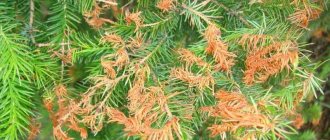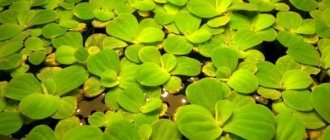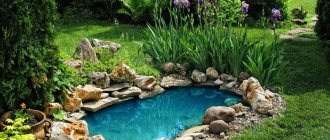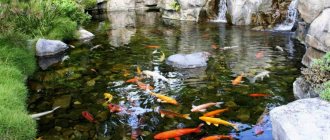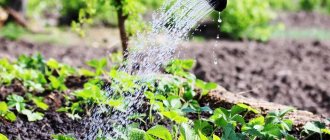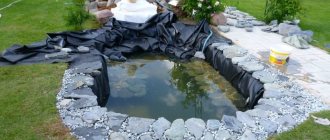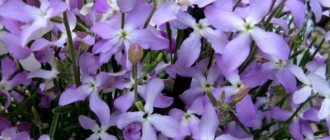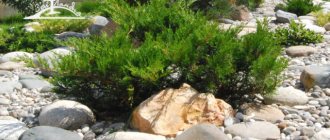In order for a garden pond to become a real highlight of your site, it must be grown. Yes, yes, we were not mistaken, namely to grow. After all, without plants it won’t be a pond, but just a big puddle. In this article we will tell and show what aquatic plants there are, at what depth they need to be planted and how to properly care for them.
An example of a successful arrangement of plants in a pond and near a pond - first water lilies come into view, then irises, and finally, magnificent rhododendron bushes growing on the shore
Follow us:
Design of the coastal zone
The first zone we will work with is called coastal. This is the area near the pond.
- Hosta. The peculiarity of the plant is that it is prone to strong growth. In nature there are low and tall species. Mostly miniature specimens are planted. Blue hostas prefer to grow in the shade, while green hostas will do better in partial shade.
- Sedge. Everyone who spent their childhood near a river knows what sedge is. The plant has narrow leaves that reach 60-80 cm in length. Until mid-winter, sedge does not change its lush appearance, therefore it is highly valued by designers and owners of personal plots. Prefers shade.
- Molinia. Cereal plants in the country house near the pond are interesting in their own way. For example, the perennial molinia. It has graceful and very narrow leaves. There are dozens of species in nature, the height of individual specimens reaches 150 centimeters. Lover of sunny, well-lit places, but not drought.
- Willow loosestrife. A marshy plant that can be safely planted near a pond. It is a bush up to 140 cm high with narrow leaves. You can easily recognize it by its purple inflorescences. It is good for a pond because it is beautifully reflected in the water, and it is completely undemanding to the conditions.
- Darmera. Most often found in large bodies of water due to its volume. Frost-resistant, unpretentious, prefers partial shade.
- Fern. You won’t believe it, but there is no better plant for a country pond than fern. Whatever species is chosen (and there are many of them in nature), it will feel just great on the shore. The height of the moisture-loving plant varies from 30 to 150 centimeters. It is advisable to plant not too close to each other - ferns often grow up to 3 meters.
- Astilbe. Astilbia completes our list of plants for the coastal zone. Gardeners choose it because of its carved leaves and beautiful head of flowers. The height varies from 40 to 200 centimeters, but low types are preferred for landscape design.
Hosta, astilbe, fern
Organization of landing
The artificial pond at the dacha has different dimensions. It can be small, which does not require much effort to decorate, or a deep body of water, the decoration of which is approached extremely responsibly. To give a natural look, natural materials (pebbles, sand, stones, driftwood) and plants are used. The latter are placed either in the reservoir itself, or planted along the coastal zone in small groups. We'll talk about the second type below.
Aquatic plants and flowers are planted directly in the water. They do not take up much space on the surface of the pond. Their role is to decorate the surface of the improvised pond. It is recommended to plant about two species in one group to avoid excessive growth.
You need to plant several types of plants
Flowers are often planted in containers or baskets. It is necessary to prepare the soil, place the flower in the basket, straighten the roots and compact the soil. The top of the soil is sprinkled with pebbles. Using a fishing line, the container is lowered into the pond and installed.
It is not recommended to plant too many plants, since their reproduction rate is high. In a short period of time, they can cover the entire surface of the water and you will have to clean the reservoir of them. Select a small number of plants that you like.
Choosing suitable plants for shallow water
A separate category for a pond at the dacha are plants that will feel great in shallow water. Great depth is unacceptable for them, and they grow poorly on land. But the area near the shore is simply ideal.
- Air. For a large reservoir, it is best to buy marsh calamus, the height of which reaches 1 m. There are also low species - for example, grass calamus with a height of 40 cm. Flowers appear in early summer. It may not be the most beautiful plant, but it is easily recognizable.
- Whitewing. What really pleases the eye is the whitewing! It is unpretentious to conditions, has large leaves and beautiful white flowers. Be aware that in summer it produces red berries that are poisonous. Be sure to warn your children about this.
- Irises. Despite the fact that iris is considered exclusively a “flower bed” plant, some of its species thrive in shallow water. Here they grow well, reaching 120 cm.
- Marsilea. This is a small perennial, somewhat reminiscent of clover. It can withstand even severe frosts and is unpretentious.
- Water mint. Creeping plant up to 50 centimeters high. It grows quickly and has soft purple inflorescences.
Marsilea, calligraphy, water mint
Planting plants in water - what to choose
When planting plants around a pond at your dacha, you should understand that certain species can grow exclusively in water. It is very convenient to plant them in pots or containers. If necessary, you can simply rearrange them and immediately change the design beyond recognition.
So, what plants can be classified as deep-sea:
- Water lily. How many legends there are about the water lily - you can’t remember them all. The first flowers appear in summer, flowering ends in October-November. The flowers are large, reaching 12-15 cm in diameter. It is recommended to plant water lilies at a depth of 1 m.
- Hawthorn. You will immediately recognize this plant by its inflorescences rising above the water and its vanilla aroma.
- Watercolor. The peculiarity of this ornamental plant is that it overwinters well at the bottom. In the spring it rises and begins to bloom actively.
- Azolla. Somewhat reminiscent of small ferns, it attracts attention with its miniature size. It covers the surface of the water quite quickly, so from time to time you will need to catch it with improvised means. Looks original, loves good lighting. In winter, it is better to remove Azolla from the pond, as it does not tolerate severe frosts.
Azolla, water lily, water lily
Help when choosing plants for a pond (video)
Decorating an artificial pond
The most long-awaited and pleasant moment comes after all technical work is completed, when you can give free rein to your imagination and begin decorating the banks of the bowl with decorative stones and planting plants.
The most difficult task that a gardener faces at this stage is to hide the unsightly plastic edge of the container protruding above the ground. Usually, two methods are used for this purpose: they cover the perimeter of the bowl with decorative stone or plant creeping carpet perennials, which, as they grow, cover the plastic with a living green carpet.
Sometimes both methods are used together. It is most natural when part of the shore is covered with plants, and the other part is decorated with stones, as is often the case in nature.
As for decorating the coastline with stone, for these purposes, most often, they use rocks that have a flat shape, for example, slate or flagstone
To hide the plastic edging of the pond, it is important to place the stones directly on it, but in this case they will stand unevenly and unstable (due to the fact that the edges of the pond usually rise above the soil)
To avoid this, you can make a concrete base-formwork around the pond, into which decorative stones are placed. But if your plans do not include a permanent design of the coastline, then you can even out the difference by placing pieces of slate, crushed stone or broken bricks under the stones. It looks very beautiful if some stones hang quite strongly over the surface of the water, while others slightly recede from the water and are covered with coastal vegetation.
Some summer residents use decorative pebbles glued to a mesh to decorate the edges of a plastic pond. You can buy similar “rugs” in large supermarkets in the bathroom tiles department.
This option is quite acceptable, but before purchasing it is important to make sure that the manufacturer used waterproof glue
Often the soil that remains after digging a hole for a pond is used to build high banks, on which something like an alpine slide is then built. Aesthetically, this technique looks good. But as soon as you start watering the newly planted plants, waterfalls of mud will flow straight into the pond
To avoid this, it is important to build slides away from the edge of the pond. In the future, the slopes are strengthened with the help of ground cover plants (for example, sedums), then this problem can be forgotten
Be sure to make a paved area near one of the banks to provide access to the water. Lyudmila Svetlitskaya
Main oxygen suppliers
To maintain the natural microflora and vital activity of the inhabitants of the pond, we recommend that you take care of planting turkish grass and hornwort. Among pond plants they are considered the most common.
By the way, “landing” is still a strong word. For example, hornwort has no roots at all, so you don’t have to bother with it. The same can be said about turcha, which is a rosette of leaves. She floats on the surface of the reservoir completely freely.
Turcha and hornwort
Despite this simplicity, the contribution of these plants to the beneficial microclimate of the pond is simply invaluable. They not only saturate the water with oxygen, but also purify the water. And with a harmonious balance, it is quite possible to create a real fairy tale on the water.
How to cover a black film on the edge of a pond
Cut a strip of geofabric wide enough to secure it to the ground without touching the water. Plant ground cover plants on the shore: periwinkle, creeping tenacious, sedum, and loosestrife. They quickly grow along the geotextile and form a dense layer of roots and stems. Then the coastline will begin to live its own life - marsh plants will settle on it, and coastal plants will grow.
When to plant
All plants are planted in the pond only after it is fully equipped and filled with water. At least 10 days should pass - this will allow the water to settle well. Planting of crops begins in early summer.
When planting flora in pots, be sure to select containers that have holes and a bottom. This is an important requirement to ensure good soil ventilation. Otherwise, the roots will quickly rot.
- What kind of soil should I use for baskets? A combination of ordinary garden soil or clay soil with the addition of bone meal is considered very successful. Many gardeners make the mistake of trying to enrich the soil with manure or fertilizers. This cannot be done, as it can cause poisoning of the inhabitants of the aquatic depths.
- How to prepare for planting? Before planting, old leaves and long roots are removed, and after planting, the soil is compacted. Of course, there are plants that do not need to be planted at all. We have already talked about them. They float on the surface of the water. However, these crops also need to be looked after. Under favorable conditions, they begin to multiply quickly. And if you don’t thin them out, the “floaters” will quickly fill the entire pond.
- How to deal with duckweed? The most affordable and effective way is to catch it regularly. Perhaps this is what is considered the main problem of any standing reservoir. Under no circumstances should you plant it on purpose.
- What to do with exotic plants? Most likely, you will still have to put them away for the winter in an aquarium or bathtub. Heavily overgrown species are pruned. In some cases, additional lighting will be needed so that the sprouts do not wither.
- Where to buy? In specialized stores they will show and tell you everything. If there is no such store in the city or you do not have the opportunity to visit it (or someone simply does not have the money), we offer an alternative. You can go to the nearest pond in your locality and carefully study the flora: at what depth it grows, what it represents. Then you select the strongest and largest specimens for your pond. In suburban and village ponds the water is stagnant, so the plants will be quite suitable for an artificial pond. To make it convenient for you to get them out of the pond, stock up on good rubber boots and a pole. We also recommend taking an assistant with you - just in case there is a firefighter.
Caring for plants in a pond (video)
Features of winter care
In winter, the decorative pond freezes. Some varieties tolerate frost well, while others need to be moved to a warm place. In order for plants to survive winter normally, the following conditions should be observed:
- Bushes that have been planted in baskets or other containers should be moved to a warm place. A cellar or other room that does not freeze is perfect. It is important to provide crops with moisture. To do this, they are placed in a container with water.
- Crops floating in a pond should be placed in a large container with water. An aquarium would be a good option. In this form, the bushes can easily survive any weather.
Once again about harmony
When creating the overall landscape design of a summer cottage along with a pond, you should not forget about the plants that will surround it. Trees growing nearby should not shade the pond. The same applies to other representatives of the flora.
Think in advance what plants will surround the pond
When doing work in the country, you should always adhere to certain rules. Trees are carefully selected taking into account their properties and compatibility, and the characteristics of the root system . The statement that trees are not planted near water is erroneous. It is easy to refute if you use a twisting willow or use moisture-loving shrubs such as mahonia, barberry, and gooseberries. It is worth paying attention to thuja.
In the first 2-3 years, experienced gardeners advise not to shade the banks at all. This will allow the flora to grow well and strengthen the root system. And don’t be confused by the fact that the appearance of the garden plot will be far from rich. Subsequently, such little things are more than compensated for by the simply fantastic view.
Advantages and disadvantages of an artificial pond
And in conclusion, I want to talk about the main disadvantages and advantages of a plastic pond, which I can confirm from my own experience.
The main disadvantages of a plastic reservoir-bowl
- No matter how hard a gardener tries, plastic garden ponds will always look a little unnatural.
- In an artificial reservoir-bowl it is more difficult to create biological balance.
- Plastic ponds are not very durable and will require replacement over the years.
- Usually, the bowls do not have sufficient depth and exclude the possibility of wintering nymphs and fish.
- A ready-made basin-bowl eliminates the possibility of using a creative approach to shape.
We installed a plastic pond in the garden 7 years ago. Lyudmila Svetlitskaya
Pros of a plastic pond
- Easy and quick installation of the finished bowl.
- Availability (can be easily purchased at any garden store or supermarket department).
- Wide selection of different configurations and sizes.
- The structure has steps on which coastal plants can be placed.
- Possibility of self-installation without the involvement of hired labor and unnecessary financial costs.
Time to take stock
Use this material to give your pond a beautiful, finished look. But do not forget that planted plants need the same proper care.
In summer, the coastal area will have to be watered, especially if it was a dry summer. Sometimes you have to deal with things like the appearance of small algae and duckweed. They also clean up.
In winter, it is recommended to move most pots and containers to the basement. We hope the article was clear to you and did not leave any gaps in your knowledge. In any case, you can always share a photo of your pond with the experts on our site.

